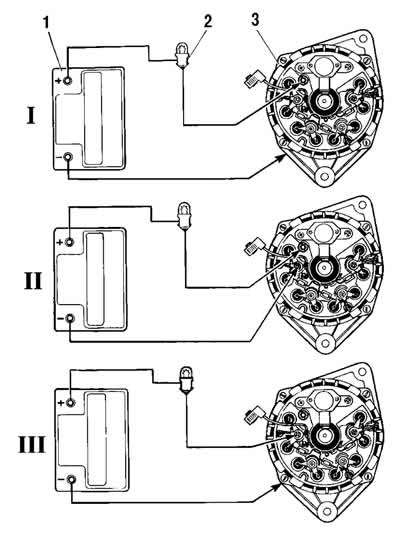If one of the rectifier diodes is damaged, the entire rectifier unit must be replaced.
A short circuit of the diodes of the rectifier unit can be checked without removing the generator from the car, after disconnecting the wires from the battery and the generator and removing the cover from the rear cover of the generator. Also disconnect the wire from the output «D+» voltage regulator. You can check with an ohmmeter or with a lamp (1-5W, 12V) and battery as shown in Fig. 7-9.

Pic. 7-9. Circuits for testing rectifier diodes:
1 - battery;
2 - control lamp;
3 - generator;
I - check at the same time «positive» And «negative» diodes;
II - check «positive» diodes;
III - check «negative» diodes.
Note. In order to simplify the fastening of parts of the rectifier, three diodes (with red mark) create on the body «plus» rectified voltage. These diodes «positive» and they are pressed into one plate of the rectifier block connected to the output «B+» generator. Other three diodes («negative» with black mark) have on the body «minus» rectified voltage. They are pressed into another plate of the rectifier unit connected to ground.
First check if there is a short circuit at the same time in «positive» And «negative» diodes. For this «plus» connect the batteries through the lamp to the clamp «B+» generator, and «minus» to the generator housing (pic. 7-9, I). If the lamp is on, then «negative» And «positive» diodes are short circuited.
To check for a short circuit in «positive» diodes «plus» connect the batteries through the lamp to the clamp «B+» generator, and «minus» - with one of the phase terminals of the stator winding (pic. 7-9, II). Burning lamp will indicate a short circuit of one or more «positive» diodes.
Short circuit «negative» diodes can be tested by connecting «plus» batteries through a lamp with one of the phase terminals of the stator winding, and «minus» with generator housing (pic. 7-9, III). Burning lamp means a short circuit in one or more «negative» diodes. It should be remembered that in this case, the burning of the lamp may also be the result of a short circuit of the turns of the stator winding on the generator housing. However, such a malfunction is much less common than a short circuit of the diodes.
A break in the diodes without disassembling the generator can be detected either with an oscilloscope, or when checking the generator on the stand for a significant reduction (by 20-30%) the magnitude of the output current compared to the nominal. If the windings, additional diodes and the generator voltage regulator are in good order, and there is no short circuit in the diodes, then the reason for the decrease in the output current is an open in the diodes.
